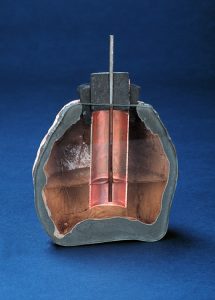This is another blog post in our SIMULIA Talks series where we talk to SIMULIA employees about current projects they are working on and developments they see in the simulation world. Recently, we asked Subham Sett, VP of Marketing & Strategic Initiatives for SIMULIA, to talk about the history of the battery and how simulation is helping to develop better batteries today.
Humans today are rightfully proud of what we have accomplished with technology, from electricity to automobiles. We may, however, be patting our modern selves on the back a little too heartily for coming up with things like batteries. In fact, we may have reinvented the wheel – or battery.

Archaeologists have discovered what appears to be an ancient form of battery, and while the artifact was found in Khujut Raju, Iraq – giving it the name “Baghdad Battery” – archaeologists believe that it was originally designed in Egypt. The battery actually consists of three artifacts: a ceramic pot, a tube of copper and a rod of iron. According to researchers, the device may have been used as a galvanic cell for electroplating or some sort of electrotherapy.
The Baghdad Battery isn’t the only piece of evidence suggesting that the ancient Egyptians may have been more technologically advanced than we give them credit for. There is also the arc lamp from the Lighthouse of Alexandria. The energy required to power the lighthouse could only have come from a regular electrical source, according to researchers.
A 2009 Netflix documentary called “The Pyramid Code” discusses the Baghdad Battery and other evidence in detail, claiming that electricity was commonly used in ancient Egyptian society. No soot has been found in the pyramids or the tombs of the Pharaohs, suggesting that electricity was used rather than flame. Relief carvings also appear to show flameless torches.
The topic is a controversial one, with some archaeologists dismissing the notion of batteries and electricity being used in ancient Egypt while others defend it. The Baghdad Battery itself has been tested and shown to produce between three and five volts, but other testing has suggested that the battery is from the early medieval period, rather than ancient times.
Regardless of the date of its origin, the existence of the Baghdad Battery does suggest that battery technology may have existed long before the 19th century, when the first practical batteries were invented. Of course, the battery has come a long way even since then.
Rather than being supplanted by other forms of technology, batteries are only becoming more advanced and powerful. Look at electric vehicles, for example. These automobiles of the future, already making an appearance on roadways today, are powered by rechargeable, extremely strong batteries rather than fossil fuel, making them an eco-friendly option in a time when such options are desperately needed.
Electric vehicle batteries still have a ways to go before becoming perfected. While LI Ion are ahead of the game in terms of production usage, newer, more efficient technologies such as solid-state and lithium-sulfur are both promising and exciting. These breakthroughs are not yet in the mainstream, making it an interesting challenge for engineers as they strive to develop batteries with greater range than those that exist today, as well as less expensive ones. Currently, the battery represents up to 50 percent of the cost of an electric vehicle.
Simulation is increasingly critical in the development of better batteries, with durability, energy efficiency, range and safety among a few key attributes that impact the overall performance of these power cells. From packing of the battery material to cell-level simulations of the chemical reactions, from individual batteries to packs and the entire module, evaluating their performance across multiple scales could very well be the difference in revealing the recipe(s) behind breakthrough solutions.
Let’s not forget the safety aspects too. Structural safety during crash, advanced in no small measure due to simulations, has made modern cars safer and more reliable. Batteries pose their own set of personal and environmental concerns when it comes to a collision scenario. While standards are being accelerated for battery safety, simulating casing failure during impact scenarios while accounting for the complex internal physics will go a long way in accounting for passenger safety post-crash.
The internal combustion engine–considered by many to be one of the greatest inventions of all time—may well be surpassed in our lifetime by the onward march of the electric vehicle. It’s remarkable to think that the humble battery, which may date all the way back to ancient Egypt, could be the invention that drives the future of transportation into the 21st century and beyond.
Learn more about simulation for electric vehicles on our trends page.
[Images: Stan Sherer/Smith Virtual Museum]
